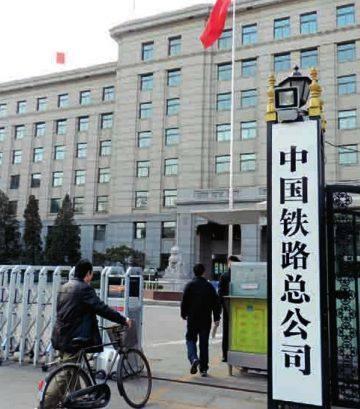Railways Under Reform
By HU JIANGYUN

ONE of the major decisions taken last March at the first session of the 12th National Peoples Congress was to carry out a fresh round of restructuring of the State Council, Chinas cabinet. Subdividing the Ministry of Railways into two arms – the State Railway Administration and the China Railway Corp – drew the most comment. The former, under the Ministry of Transport, is responsible for safety supervision and establishing technological standards on the railways, and also for monitoring the quality of transport services and railway projects. The China Railway Corporation, unveiled on March 17 at the headquarters of the dissolved ministry, handles railway transportation dispatch and command, freight and passenger transport business management and railway construction.
Government ministry reshufflings are nothing new in China. Since setting the goal in 1992 of establishing a socialist market economy, the nation has rolled out extensive reforms to its state-owned enterprises, State Council departments and financial and fiscal systems, among others. Twenty years later, this goal has yet to be achieved, due largely to the absence of clear demarcation between government and market functions. The government still intervenes in fields that are, in theory, the realm of businesses. Such meddling in the micro activities of market players impedes their efficient operation, most prominently in monopoly industries such as railways, telecommunications and petroleum.
As repercussions of the 2008 global financial crisis continue to ripple through China, certain regional governments are becoming mired deeper in debt. The central government has also been running deficits for consecutive years, because, despite massive investments, monopolistic industries like the railways pile up debts. Revelations of corrupt practices within the railway system as well as recent accidents, notably the fatal crash in July 2011 killing 40 people on the Ningbo-Wenzhou line, have finally prompted the government to regroup the railway authority.
The aim of the reform is to allow government and businesses to carry out their respective functions by separating railway network management from train operation, so breaking the current monopoly and introducing competition into the equation. Upon the governments bowing out to perform a strictly administrative role, the railway system can operate entirely according to market rules. Its economic efficiency will thus improve. It is the shared opinion among Chinese and international researchers that successful reform of Chinas railway system entails keeping it under unified control. In other words, the system should define the respective functions of government departments and commercial operators and be subject to market supervision.
China can learn from other countries in this respect. Although we dont agree with privatization of the railway system in general, we can nonetheless consider the salutary attempts and practices certain countries have adopted.
The UK kicked off reforms to its railway system in the early 1990s, in response to low rail transport efficiency and mounting debts. The privatization of British Rail took place during the period 1993-1997, when its functions were split among 120-odd companies. Ownership of track and infrastructure was passed to Railtrack, passenger operations were franchised to 26 private operators, and freight services were sold to six companies. More businesses were also established to provide train charters, sources of railway equipment manufacturing and maintenance services.
But several serious rail accidents in the wake of the privatization program ignited a public outcry, triggering a wave of renationalization.
In March 2010, the Guardian published an article entitled “Rail Privatization Has Failed –and the NHS Is Hurtling down the Same Track.”Journalist Oliver Huitson also observed that British rail fares are now the most expensive in the world. Even former Conservative transport minister Philip Hammond conceded that trains had become “a rich mans toy.” He estimated that if Britons were to pay the same fares as the French do for their nationalized service they could save more than ?4 billion a year. A 2009 poll showed that 51 percent of people in the UK are in favor of renationalization of the railways, including a third of Conservative voters. Only 11 percent backed the current model. “Rail privatization has failed in the most unequivocal terms,” Hammond concluded.
Chinas reform of its railways is not intended to privatize them. We fully acknowledge that the railway system is not an inherently competitive industry. Fragmenting it under rival operators would moreover run counter to the railways fundamental character of providing public service. Such segmentation would inevitably increase operational costs and consequently drive up fares, which could tempt certain operators to cut corners or cut back services.
Chinese reform is foremost about neutralizing government omnipotence over the railways to make room for corporate management. Competition is necessary if this erstwhile monopolistic sector is to improve work efficiency and services.
Details of the restructuring of Chinas railways are yet to be laid down. But one thing is clear: given the complexity of Chinas railway system, the program to streamline it will take years and cannot merely ape an existing template.
Chinas railways have played a pillar role in social and economic development, and are on the whole the preferred mode of conveyance. The countrys rail system operates the worlds largest volume of passenger transport, and its rail freight ranks second globally. Every year hundreds of millions of Chinese people board trains to spend national holidays with their families in other parts of the country, or to take vacations. Reasonable ticket prices also make trains a relatively desirable mode of transport.
Successful reform calls for a complete set of regulations upon market entry, fair competition and market supervision that support the participation of various businesses in railway operation, and the establishment and guarantee of a good market order. Measures need also be taken to ensure that government departments abide by specific rules on supervision of market competition and price setting. Market entry and market order are the two acknowledged weak links in the socialist market economy that China is still working on. They therefore merit particular attention amid the ongoing reforms to the nations railway system.

